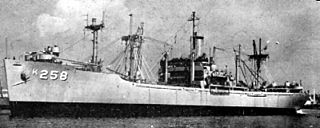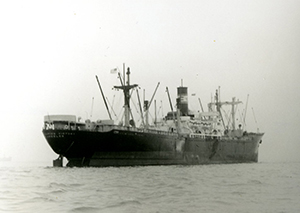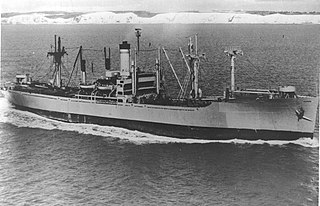
The SS M. I. T. Victory was a Victory ship built during World War II and used as a troop transport. She was later named USAT MIT Victory and finally USAT Lt. Alexander R. Nininger. Note: In 1944 there was a different transport ship named Alexander R. Nininger, Jr..

USS George F. Elliott (AP-105) was a cargo liner built for the Mississippi Shipping Company as SS Delbrasil for operation between New Orleans and the east coast of South America in 1939 by its operator, Delta Line. The ship entered that service and operated until taken over by the War Shipping Administration (WSA) on 28 April 1942 for operation by Delta Line acting as WSA's agent. On 25 August 1943 WSA allocated the ship to the Navy for conversion to a troop transport commissioned and operated by the Navy for the duration of the war. Ownership of the ship was transferred from Mississippi Shipping to WSA on 4 February 1944 while under Navy operation and was retained until sale to American South African Lines on 22 December 1948. The ship was renamed African Endeavor until returned as a trade in to the Maritime Commission on 22 September 1960 for layup in the James River reserve fleet and later sold to Boston Metals for scrapping.

The Type C4-class ship were the largest cargo ships built by the United States Maritime Commission (MARCOM) during World War II. The design was originally developed for the American-Hawaiian Lines in 1941, but in late 1941 the plans were taken over by the MARCOM.

Empresa Líneas Marítimas Argentinas (ELMA) was an Argentine cargo shipping line formed on September 30, 1960, after Juan Perón nationalised the shipping industry. The Argentine Maritime Lines Company involved the merger of two companies, both state: the Merchant Fleet of the State (FME) and Argentina Fleet of Navigation of Ultramar (FANU). It served Argentina's foreign trade until the 1990s, when the government of Carlos Menem declared its dissolution. At its peak its fleet had more than 60 ships. Ships sailed to Northern Europe, the United Kingdom, the Baltic Sea, the Mediterranean, the east coasts of the United States of America and Canada, the Gulf of Mexico, the Pacific, the Middle East and Far East and Africa.

The second USS Antares (AK-258) was a United States Navy Greenville Victory-class cargo ship in commission from 1952 to 1959. She was converted into a general stores issue ship (AKS-33) in 1959–1960 and remained in commission as such until 1964. She saw extensive service during the Cold War. Prior to her U.S. Navy career, she had operated as the merchant ship SS Nampa Victory during the latter stages of World War II and in the years immediately after the war.

SS Cedar Rapids Victory was the 77th Victory ship built during World War II under the Emergency Shipbuilding program. She was launched by the California Shipbuilding Company on January 14, 1945, and completed on February 17, 1945. The ship’s United States Maritime Commission designation was VC2-S-AP3 and her hull number was 77. Her operator was the American West African Line.

The SS Claremont Victory was the 18th of 531 Victory ships built during World War II. She was built in the Oregon Shipbuilding Corporation shipyard in 1944. She served during the Battle of Okinawa. After the war, she was owned by a number of merchant shipping companies in Argentina before being scrapped in 1978.

The SS U.S.S.R. Victory was the third Victory ship built during World War II under the Emergency Shipbuilding program. She was launched by the California Shipbuilding Company on February 26, 1944. The ship was completed and delivered to the wartime operator of all United States oceangoing shipping, the War Shipping Administration (WSA), on April 26, 1944. U.S.S.R. Victory, official number 245247, was assigned to Moore-McCormack Lines, Inc., under a standard WSA operating agreement at that time. That agreement continued until the ship's sale on March 7, 1947. The ship’s United States Maritime Commission designation was VC2-S-AP3, hull number 3 (V-3). U.S.S.R. Victory served in the Atlantic Ocean during World War II.

The SS United States Victory was the fourth Victory ship built during World War II under the Emergency Shipbuilding program. She was launched by the California Shipbuilding Company on March 6, 1944 and completed on April 30, 1944. The ship’s United States Maritime Commission designation was VC2- S- AP3, hull number 3 (V-3). SS United States Victory served in the Pacific Ocean during World War II. The 10,500-ton Victory ships were designed to replace the earlier Liberty Ships. Liberty ships were designed to be used just for World War II. Victory ships were designed to last longer and serve the US Navy after the war. The Victory ship differed from a Liberty ship in that they were: faster, longer and wider, taller, had a thinner stack set farther toward the superstructure and had a long raised forecastle.

SS Rushville Victory was a Victory ship-based troop transport built for the US Army Transportation Corps (USAT) late in World War II under the Emergency Shipbuilding program. It saw service in the European Theater of Operations in 1945, 1946 and in the immediate post-war period repatriating US troops.

SS Bozeman Victory was a Victory ship built during World War II under the Emergency Shipbuilding program. It was built and launched by the Oregon Shipbuilding Corporation on December 9, 1944 and completed on February 17, 1945. The ship's United States Maritime Commission designation was VC2-S-AP3 and hull number 151 (1205). She was built in just 106 days. The Maritime Commission turned it over for Merchant navy operation to a civilian contractor, the Alaska SS Company under the United States Merchant Marine act for the War Shipping Administration. She was named after the city of Bozeman, Montana.

SS Attleboro Victory was a Victory ship built for the War Shipping Administration late in World War II under the Emergency Shipbuilding program. It saw service in the European Theater of Operations in the Atlantic Ocean during 1945, and in the immediate post-war period. Attleboro Victory was part of the series of Victory ships named after famous cities. This particular ship was named after the city of Attleboro, Massachusetts. It was a type VC2-S-AP2/WSAT cargo ship with the United States Maritime Commission (MCV) -"Victory"; hull number 642, shipyard number 1597 and built by Bethlehem Shipbuilding Corporation in Baltimore, Maryland. Phyllis O'Neil of Attleboro, Massachusetts christened Attleboro Victory with a champagne bottle.

SS Georgetown Victory was a Victory ship built for the War Shipping Administration late in World War II under the Emergency Shipbuilding program. She was a type VC2-S-AP2/WSAT cargo ship with the United States Maritime Commission (MCV) -"Victory"; hull number 653, shipyard number 1597 and built by Bethlehem Shipbuilding Corporation in Baltimore, Maryland, she was laid down on 8 March 1945. Georgetown Victory, named after Georgetown University, was launched from the Bethlehem-Fairfield shipyard at Baltimore on April 28, 1945 and completed on 22 May 1945.

SS N. Y. U. Victory was a Type C2 Victory ship-based VC2-S-AP2 troop transport built for the U.S. Army Transportation Corps late in World War II. Launched in May 1945, it saw service in the European Theater of Operations in the immediate post-war period repatriating U.S. troops.

SS Whittier Victory was a Victory ship which saw brief service in the Pacific Theater of Operations during the waning months of World War II and Vietnam War from 1966–1969. Built in June 1945, she carried ammunition and other cargo from U.S. West Coast ports to Southeast Asia, then ferried cargo, equipment and troops back to the U.S. after the war ended. She survived one hurricane. Whittier Victory spent time between 1946 and 1966 chartered to commercial carriers and the two times in U.S. reserve fleets. From 1966 to 1969 she delivered cargo to Southeast Asia in the Vietnam War.

The SS Berea Victory (MCV-734) was a type VC2-S-AP2 Victory-class cargo ship built for the United States during World War II. The ship was built as part of the Emergency Shipbuilding program by Permanente Metals Corporation in Yard 2 of the Richmond Shipyards in Richmond, California. Launched on 3 March 1945, the Berea Victory delivered supplies for the Pacific War.

SS Smith Victory was a Victory ship cargo ship built for the U.S. Maritime Commission during the final months of World War II. She was converted to be a troop ship.

SS St. Albans Victory was a Victory ship cargo ship built for the U.S. Maritime Commission during the final months of World War II. She was converted to be a troop ship.

The SS Tufts Victory was a class of Victory ship built during World War II under the Emergency Shipbuilding program. She was launched by the California Shipbuilding Company on 2 March 194. The ship was completed and delivered to the wartime operator of all United States oceangoing shipping, the War Shipping Administration (WSA), on 28 March 1945. Tufts Victory, official number 247512, was assigned to American Mail Line, under a standard WSA operating agreement at that time. That agreement continued until the ship's sale in 1947. The ship's United States Maritime Commission designation was VC2-S-AP3, hull number 771. Tufts Victory was converted from a cargo ship to a troopship to bring troops home after the war as part of Operation Magic Carpet.

The SS Wheaton Victory was a class of Victory ship built during World War II under the Emergency Shipbuilding program. She was launched by the California Shipbuilding Company on 22 March 1945. The ship was completed and delivered to the wartime operator of all United States oceangoing shipping, the War Shipping Administration (WSA), on 14 April 1945. Wheaton Victory was assigned to Marine Transport Line, under a standard WSA operating agreement at that time. That agreement continued until the ship's sale in 1947. The ship's United States Maritime Commission designation was VC2-S-AP3, hull number 776. Wheaton Victory was converted from a cargo ship to a troopship to bring troops home after the war as part of Operation Magic Carpet.












